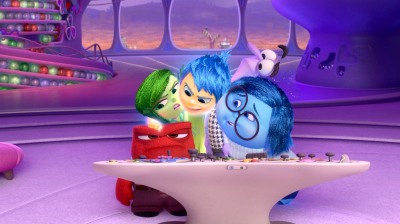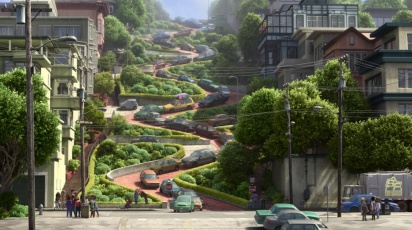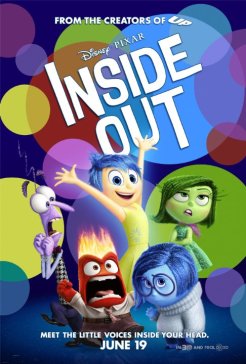Throughout the past two weeks, when I’ve been asked to go see a movie, I haven’t cut off the asker with an enthusiastic “YES OF COURSE!” like I normally do. Why? Because frankly, the movies that have hit the theaters in the past couple of weeks haven’t piqued my interest. It’s been one of those rare movie-drought periods in my life, which I expect will end on July 17th with the release of Ant-Man, The Stanford Prison Experiment, and of course Southpaw starring Jake Gyllenhaal on the 24th. But until then, I’ve had little interest in Jurassic Park or Terminator (I haven’t seen any prequels), and I don’t usually care to see children’s movies, especially in the theater where I have to pay for them (Exception: Toy Story 3).
However, after hearing positive comments from friends about Inside Out, and starved for a movie-going experience, I decided to give it a go at my favorite theater, St. Anthony Main, which only charges $6.00 for students (How cool is that?!?).
The movie my already high expectations, thanks to glowing reviews and a 98% on Rotten Tomatoes. I was sucked in from the beginning, which was actually my favorite part, as Joy (voiced by Amy Poehler) tours us around the colorful and imaginative world that is inside Riley’s head. Seriously, Pixar, your writers know what they’re doing.
The story then shifts to eleven-year-old Riley’s life, which is in for a big change: her family is moving from Minnesota (The theater erupted in cheers when we learned where she lived) to San Francisco. The personifications of emotions that live inside her head (Joy, Sadness, Fear, Anger, and Disgust) have their work cut out for them to keep Riley happy. Joy leads the team as Riley encounters new experiences that tell her just how different California and Minnesota are. I have to admit, as a Parks and Rec fan, it was a joy to see that Joy’s character (pun intended) was basically the same as Amy Poehler’s Leslie Knope: peppy with a do-gooder attitude.

By the end of the movie, My stomach was sore from the many times I laughed, and I even teared up once. Needless to say, as my boyfriend and I left the theater, the first thing we talked about was what a success the movie was and how happy we were that we decided to finally see it. But I was hung up on one thing: What is this movie trying to tell us about our feelings? Is it suggesting that we’re slaves to our emotions?
I know that it’s a children’s movie, and of course there are no little people living inside our heads, and it maybe isn’t meant to be considered too seriously. But that’s how my mind works, so of course I have to question it. And every movie has a message (especially, many would argue, childrens’ movies, so maybe that makes my question even more troublesome?). I have spent a great deal of time thinking about this since the movie ended, and haven’t come to a firm conclusion. But, without giving away any spoilers, I’ll stack up the evidence I can to try to determine what Inside Out is telling us about our feelings.
Argument: We are slaves to our emotions
From the very beginning of Riley’s life, there has been a control panel in the “headquarters” of her mind, and little feeling personifications to push its buttons. As Riley grows up, she can control what she says and does, but feelings largely control both of these things, and ultimately, they have the control panel. For example, when Riley sees her new room, she is disappointed, but Joy takes control of the panel, and Riley begins to imagine how great she can make her room look once her furniture arrives.

When Joy and Sadness accidentally land themselves far away from headquarters, leaving Fear, Anger, and Disgust in control, the trio decides the Riley would be better off going back to Minnesota, and Anger gets an idea that he then plugs into Riley’s head, essentially thinking for her.
The memories that are stored up in Riley’s mind glow certain colors to reflect the feelings that are associated with them. Many of them glow yellow before the move (because Joy is yellow and she is a hard worker!), but as the move progresses, the little orb-memories can change from yellow to blue with a touch of Sadness’s hand.
Argument: Feelings are there, but we have the power to influence them and behave independent of them
Almost every argument that I made above could also act in the favor of this main argument, if only we look at them from a different angle. For example, Sadness didn’t mean to turn the happy memories from yellow to blue, which might mean that she is under some sort of superior control (aka Riley). This might seem a bit confusing, because aren’t I still suggesting that Riley is subject to her emotions? Yes, I am, But I guess what I’m saying here is that it’s normal for an eleven-year-old girl to miss her home and her friends, and no matter how hard Joy works to prevent it, those feelings need to be acknowledged. Another example of this is when Joy commands Sadness to stay inside a chalk-drawn “sadness circle,” but Sadness wanders out anyway, saying things like “Sorry, I didn’t mean to,” and “I ruin everything.” Well, if she didn’t mean to, why did she? It doesn’t seem like she is in control of herself in the more extreme emotional situations.
In addition to Sadness’s fumbles, the world of Riley’s mind holds greater power than the emotions themselves. As Joy and Sadness persevere to make it back to headquarters, the world through which they wander repeatedly breaks down and throws obstacles their way, preventing their return. It seems like nothing that Joy and Sadness can do will bring them back to Riley. They are powerless. If we take a step back and look at what’s going on in Riley’s life at this time, their hopeless journey makes sense. It’s normal for a young girl to be emotionally numb when going through such a transition, and again, no matter how much Joy wants to be in control, she is shot down time after time. One example of this is when Joy tries to ditch Sadness by entering a chute that would take her back to headquarters, shouting down that “Riley needs to be happy!” The chute breaks, and Joy is once again stranded with her opposite.
Joy and Sadness return to Riley when nature (or who/whatever) intends. Joy learns a valuable lesson that teaches her not to monopolize the control panel.
In conclusion?
So, you could watch this movie and argue either way. I think the second argument takes a bit more work to see, and if it is the message the movie was going for, I wish it was a bit clearer. And then again, maybe neither argument is the answer. Maybe this movie was supposed to be read as a child being a slave to her emotions, and if there were to ever be an Inside Out 2, we would see Riley learning to overpower her emotions as she begins to grow up. However, we do get glimpses into adult minds throughout the movie, and their emotions function much the same as Riley’s. As you can see, there are many pieces of evidence to be considered, and for the most part, they lead me in circles. So in the end, I have to say that the reading of this movie will vary per viewer. Many might not even considered the question I raised. But one thing’s for certain: you will enjoy it!
Fun Fact
One other thing I want to mention about this movie is that many of the scenes capture San Francisco to a T. The Golden Gate Bridge, Riley’s school, and even the pizza place she and her mom visit are all very real places. I was thrilled to see that Disney-Pixar also included a good shot of Lombard Street, which is the most crooked street in the world and also the location of my ultimate dream house.


For those of you who have visited the city by the bay, or even live in San Francisco, look for shots like this and more throughout the movie!
So check out Inside Out, if you FEEL up to it! (See what I did there?)

Extremely interesting post! I also pondered over the take-away from this awesome movie. At first I thought Riley’s actions were entirely controlled by her personified feelings, but I think feelings are actually pretty vulnerable, and influenced by our environment. And I did not realize that Lombard street made an appearance!! How perfect! You have a keen eye and a thought provoking spirit.
LikeLike